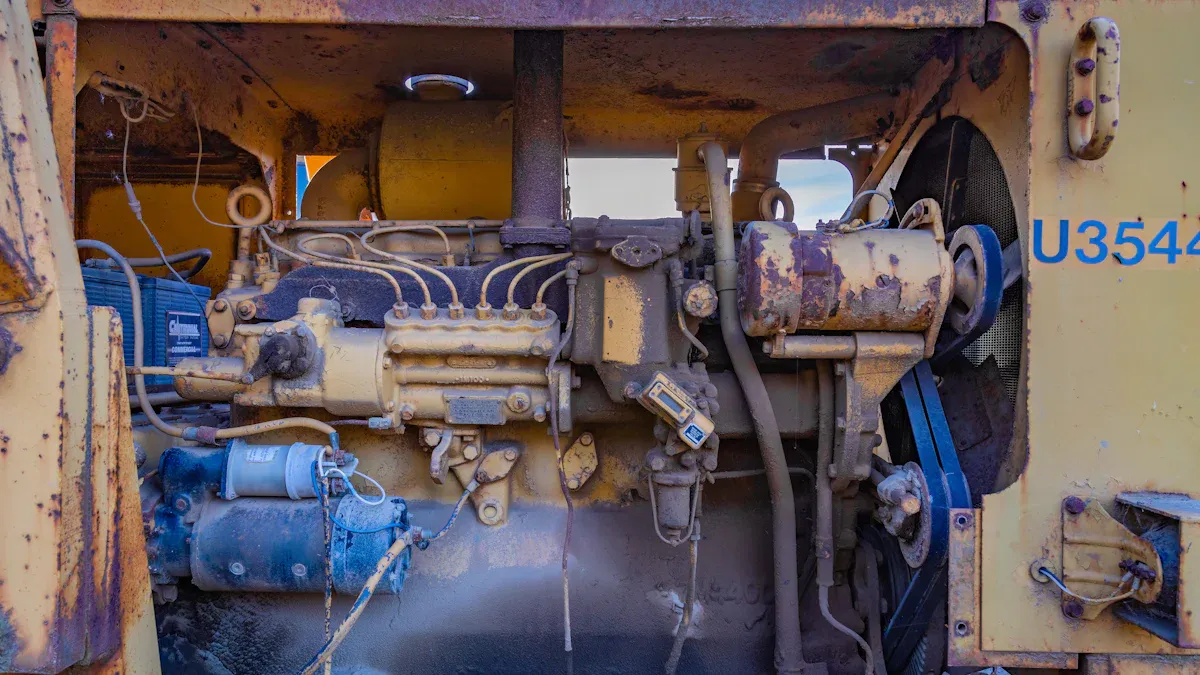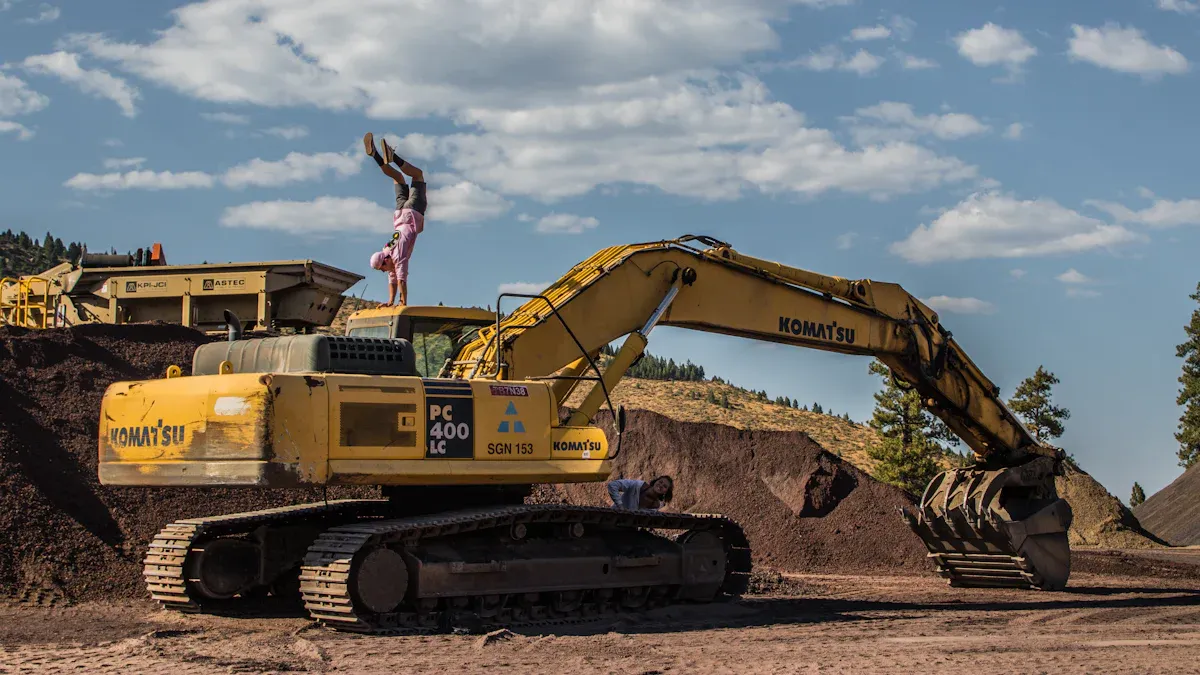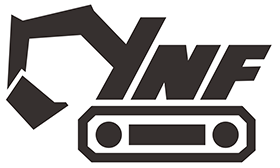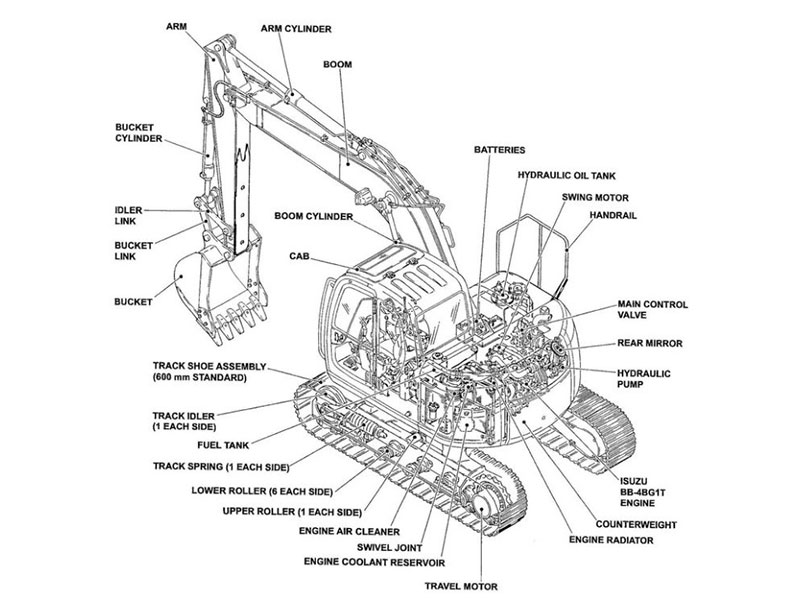
Komatsu excavator engine parts are carefully designed to work efficiently. Each part, like the cylinder block and fuel system, plays a crucial role. These engines focus on saving fuel and protecting the environment, meeting US EPA Tier-2 exhaust rules for cleaner air. Their design lowers noise and keeps repair costs low. For instance, models like the PC-2000-8 utilize less fuel and are dependable for tough jobs. Understanding how komatsu excavator engine parts function helps keep them running well and prevents expensive repairs.
Key Takeaways
Knowing Komatsu excavator engine parts helps avoid expensive repairs.
Taking care of parts like the cylinder block and fuel system keeps it working well.
Using good-quality parts, like Komatsu fuel lines, makes it reliable and cleaner.
Checking the electrical system, like the starter motor, prevents problems.
Regular maintenance can increase how much your excavator is worth later.
Core Engine Components

Cylinder Block
The cylinder block is the main part of the engine. It holds important pieces like cylinders, pistons, and the crankshaft. This block gives support to the engine and helps it run smoothly. Inside the cylinders, fuel burns to create power for the excavator. The block is made from strong materials like cast iron or aluminum. These materials can handle high heat and pressure. If the cylinder block doesn’t work well, the engine won’t run properly.
Pistons and Connecting Rods
Pistons and connecting rods are key parts of the engine. Pistons move up and down in the cylinders to mix air and fuel. This creates energy by burning the mixture. The connecting rods attach the pistons to the crankshaft. They send the energy from the pistons to the crankshaft. Together, these parts turn energy into motion to power the excavator. Checking these parts often helps avoid damage and keeps them working well.
Crankshaft
The crankshaft is a major part of the engine. It changes the pistons’ up-and-down motion into spinning motion. This spinning powers the excavator’s hydraulic system and other parts. The crankshaft also keeps the engine balanced and running smoothly. It is built to handle heavy pressure and spin without problems. Oil is needed to keep the crankshaft working and prevent expensive fixes.
Camshaft
The camshaft controls when the engine’s valves open and close. It makes sure the intake and exhaust valves work at the right time. This timing helps the engine run well and produce strong power. The camshaft works with the crankshaft using a belt or chain to stay in sync.
Think of the camshaft as the “leader” of the valve system. It uses cams to push valves open, while springs close them. This movement controls air and exhaust flow, affecting engine performance. If the camshaft wears out or shifts, the engine may lose power or stop working. Regular checks can catch problems early and save money on repairs.
Modern Komatsu excavators have advanced camshafts that save fuel and cut pollution. These designs show Komatsu’s focus on protecting the environment. Taking care of the camshaft keeps the excavator running well and meeting job needs.
Cylinder Head
The cylinder head is a key part of the engine. It sits on top of the cylinder block and seals the combustion area. It holds valves, spark plugs (for gas engines), and fuel injectors. Its job is to control air and fuel flow into the cylinders and let exhaust gases out.
A good cylinder head helps the engine work efficiently. Cracks or leaks can cause overheating, poor performance, or engine failure. Watching coolant pressure can spot early signs of gasket problems in the cylinder head.
Komatsu experts have shown how checking cylinder heads can prevent big repair costs. Regular maintenance helps avoid issues and keeps the engine safe. A strong cylinder head protects other parts like the hydraulic system from damage.
The cylinder head is built to handle high heat and pressure. This makes it reliable for tough jobs. Whether you’re using hydraulic cylinders or the stick, a healthy cylinder head keeps the excavator working smoothly.
Fuel System
The fuel system in Komatsu excavators delivers fuel to the engine. This helps the machine run smoothly and work efficiently. Each part is important for keeping the excavator reliable and saving fuel.
Fuel Pump
The fuel pump is a key part of the system. It moves fuel from the tank to the engine at the right pressure. This ensures the engine gets enough fuel to work properly. If the pump fails, the excavator might lose power or not start.
Modern Komatsu excavators have strong, efficient fuel pumps. These pumps use less fuel and keep the engine running steadily. Checking the pump often can catch problems early and avoid expensive repairs.
A study showed Komatsu HB215 hybrids use less fuel than PC200 and PC220 models. This proves how a good fuel pump helps save fuel and lower pollution.
Fuel Injectors
Fuel injectors spray fuel into the engine in a fine mist. This mixes the fuel with air for better burning. Good injectors improve engine power, save fuel, and cut emissions.
Tests show higher injection pressure boosts engine power and saves fuel. Cleaning injectors can make them work like new, saving money on replacements.
Taking care of injectors prevents engine problems. Regular cleaning keeps the fuel spraying evenly, helping the excavator handle tough jobs like moving the stick or hydraulic cylinders.
Fuel Filter
The fuel filter cleans fuel before it reaches the engine. It removes dirt, water, and other harmful stuff. A clean filter protects engine parts and helps them last longer.
Komatsu fuel filters are very effective. For example:
Specification | Value |
|---|---|
Efficiency | 99% |
Efficiency Test Standard | SAE J1985 |
Emulsified H2O Efficiency | 95% |
These filters meet high standards and work well in tough conditions. Replacing the filter on time stops clogs and keeps the hydraulic system clean.
Keeping the fuel filter clean is important for the engine and hydraulic system. A good filter helps the excavator run smoothly and reduces repair costs.
Fuel Lines
Fuel lines carry fuel from the tank to the engine. They make sure fuel flows smoothly without leaks or dirt. If fuel lines don’t work, the engine won’t run well.
Komatsu fuel lines are made from strong materials like rubber or metal. These materials can handle heat, pressure, and vibrations. Checking fuel lines often helps find cracks, leaks, or clogs early.
A broken or blocked fuel line can cause engine problems. The engine might not start or lose power while working. This can make it hard for the excavator to do its job. Replacing damaged fuel lines quickly keeps fuel flowing and avoids big repairs.
To keep fuel lines in good shape, look for damage and loose connections. Clean them regularly to remove dirt that could block fuel. Using clean, high-quality fuel also helps prevent problems.
Komatsu fuel lines are designed to work well with other engine parts. This helps the excavator run smoothly, even in tough conditions. Taking care of fuel lines helps the engine and hydraulic system work better.
Tip: Always use Komatsu-approved fuel lines for replacements. This ensures they fit and last longer.
Air Intake and Exhaust System
Air Filter
The air filter keeps dirt and dust out of the engine. It ensures clean air enters for better fuel burning. Clean air helps the engine work efficiently and stay strong. A dirty air filter can lower power and waste fuel. It might even harm the engine if not replaced.
Check the air filter often and change it when needed. Komatsu air filters are tough and work well in dusty areas. Keeping the air filter clean protects the engine and helps the hydraulic system work better.
Turbocharger
The turbocharger makes the engine stronger by pushing in more air. This lets the engine burn extra fuel for more power. Komatsu uses special Variable Geometry Turbochargers (VGT) for better performance.
The VGT changes the turbine size to improve airflow.
A hydraulic cylinder moves the turbine for faster spinning at low speeds.
This setup saves fuel, cuts pollution, and keeps engine power steady.
With a turbocharger, the excavator can handle heavy tasks easily. Regular care keeps the turbocharger working well and supports the machine’s reliability.
Exhaust Manifold
The exhaust manifold gathers gases from the engine and sends them out. It helps control engine pressure and temperature for smooth running. A good exhaust manifold stops harmful gases from leaking.
Komatsu makes exhaust manifolds strong to handle heat and pressure. Checking for cracks or leaks can avoid engine problems and big repair costs. A healthy exhaust manifold helps the excavator work well in tough jobs.
Muffler
The muffler helps lower engine noise and control exhaust gases. It keeps the excavator quiet and follows environmental rules. Without it, the engine would be loud and could bother workers or harm hearing.
How Does the Muffler Work?
The muffler has chambers and baffles that absorb sound waves. It guides exhaust gases through paths to break up noise before releasing them. This process also cools the exhaust gases.
Tip: Check the muffler often for rust or cracks. A damaged muffler can make the engine louder and increase pollution.
Benefits of a Well-Maintained Muffler
Noise Reduction: A clean muffler keeps the excavator quieter for sensitive areas.
Emission Control: It filters harmful gases, helping the air stay cleaner.
Engine Efficiency: A working muffler stops backpressure, letting the engine run better.
Signs Your Muffler Needs Attention
Louder engine sounds
Rust or cracks on the muffler
Lower engine performance
Fix or replace the muffler if you see these problems. Komatsu mufflers are tough, but regular care makes them last longer.
🛠️ Pro Tip: Always use Komatsu-approved mufflers for replacements. They fit well and keep the excavator working properly.
Taking care of the muffler helps the engine work better and creates a quieter, safer workspace.
Cooling System
Radiator
The radiator helps keep the engine from getting too hot. It moves heat from the coolant to the air around it. Thin tubes and fins in the radiator help release heat faster. As coolant flows through, heat escapes into the air.
A clean radiator keeps the engine working well, even during hard jobs. Dirt and dust can block it, making it harder to cool the engine. Clean and check the radiator often to keep it working. If the engine gets too hot, look for clogs or leaks in the radiator.
Water Pump
The water pump moves coolant through the engine and radiator. It makes sure all hot parts of the engine get cooled. Without it, the coolant would stop moving, and the engine could overheat.
Think of the water pump as the cooling system’s heart. It pushes coolant through the engine block, cylinder head, and radiator. Komatsu uses strong water pumps that handle tough conditions. Check the water pump often to avoid problems that could harm the engine or hydraulic system.
Thermostat
The thermostat controls the engine’s temperature by managing coolant flow. When the engine is cold, it stays closed to warm it up faster. Once the engine is warm, it opens to let coolant flow to the radiator.
A broken thermostat can cause big issues. If it stays closed, the engine might overheat. If it stays open, the engine may not warm up enough, lowering efficiency. Checking the thermostat helps the engine run well and stops the hydraulic system from overheating.
Tip: Use good-quality coolant and follow Komatsu’s care tips to keep the cooling system working its best.
Cooling Fan
The cooling fan helps keep the engine from overheating. It pushes air through the radiator, letting heat escape quickly. Without it, the engine could get too hot and break down. Fixing an overheated engine can be very expensive.
Komatsu excavators use advanced cooling fans for tough jobs. One example is the RCV2000 variable-speed fan drive. This fan adjusts airflow using viscous technology to match the engine’s needs. It saves energy, improves fuel use, and works well in mining and construction.
Feature | Details |
|---|---|
Product | RCV2000 variable-speed fan drive |
Application | Used in Komatsu excavators and mining tools |
Benefits | Boosts uptime, cuts emissions, lowers noise |
Technology | Viscous tech for better airflow |
Maintenance | No maintenance needed |
Testing | Tested in mining labs |
Durability | Built for harsh conditions |
A clean, working fan keeps the excavator reliable in hard conditions. Check the fan often for cracks, loose parts, or dirt. Cleaning it and the area around it helps airflow stay strong.
Komatsu fans are also quieter, making the worksite more comfortable. This reduces noise for workers and meets environmental rules.
🛠️ Pro Tip: If the engine overheats or the fan gets loud, inspect it right away. Catching problems early can save money and prevent delays.
Taking care of the cooling fan helps the excavator stay strong and ready for tough tasks.
Electrical System
The electrical system in a Komatsu excavator helps it start and run. It powers important parts and keeps the machine working well.
Starter Motor
The starter motor helps the engine start by turning its crankshaft. It uses power from the battery to begin the combustion process. If the starter motor doesn’t work, the engine won’t start.
Check the starter motor often for problems like slow cranking or strange sounds. Dirt and rust can make it work poorly. Clean the connections and check the voltage to keep it working longer.
Modern Komatsu excavators have strong starter motors for tough jobs. These motors handle frequent starts in hard conditions. Taking care of the starter motor ensures the machine starts every time.
Alternator
The alternator makes electricity to power the excavator’s systems and charge the battery. It changes energy from the engine into electricity. This keeps lights, sensors, and other parts working without draining the battery.
If the alternator fails, lights may dim, or the battery might weaken. Check the alternator belt for wear and make sure it’s tight. Regular checks can stop sudden breakdowns.
Komatsu alternators are made to last and work well. They give steady power, even during heavy tasks. Keeping the alternator in good shape avoids costly repairs and keeps the machine running.
Battery
The battery stores power to start the engine and run systems when off. It also provides backup power for important parts.
Look at the battery terminals for rust and ensure they’re tight. A weak battery can cause starting problems or stop the system from working. Replace old batteries to avoid delays.
Komatsu batteries are tough and reliable in harsh conditions. They are key for starting the engine and powering the excavator. Caring for the battery ensures smooth operation on job sites.
Engine Control Unit (ECU)
The Engine Control Unit (ECU) is like the excavator’s brain. It controls and checks systems to keep the engine working well. The ECU uses sensor data to adjust how the engine runs. This helps the excavator save fuel and handle tough jobs.
One important job of the ECU is managing fuel use. It balances air and fuel based on the work and surroundings. This gives steady power without wasting fuel. The ECU also helps lower pollution. It controls parts like the Exhaust Gas Recirculation (EGR) system and catalytic converter to meet clean air rules.
The ECU makes fixing problems easier by saving error codes. These codes show technicians what’s wrong, saving time and effort. For example, it can find broken sensors or software issues. Regular tests keep the ECU working well. These tests include checking sensors, testing outputs, and updating software.
Komatsu excavators have strong ECUs built for tough jobs. They check for problems, improve engine performance, and follow environmental rules. Taking care of the ECU helps your excavator last longer and avoid expensive fixes.
Tip: Run ECU tests often to find problems early. This keeps your excavator reliable and avoids sudden breakdowns.
The ECU is a key part of the excavator. Keeping it in good shape ensures the machine works well on hard tasks.
Komatsu excavator engine parts work together to keep the machine reliable. Each part, like the cylinder block and cooling fan, is important. These parts help the excavator run smoothly and do its job well. Taking care of them regularly stops problems and makes the machine last longer. Programs such as Komatsu Care provide maintenance for up to three years or 2,000 hours. This helps save money and keeps the equipment working better.
Knowing how these engine parts work helps you take care of them. This smart approach avoids costly repairs and keeps the excavator running longer. It also boosts resale value when selling the machine. Keeping all parts in good shape ensures the excavator can handle tough tasks without trouble.
FAQ
What makes Komatsu excavator engines reliable?
Komatsu engines are built with strong materials and smart designs. They are made to last, save fuel, and reduce pollution. Regular care helps them work well in tough jobs.
How often should you replace the air filter?
Check the air filter every 250 hours or as the manual says. Change it if it looks dirty or blocked to keep the engine working well.
Why is the cooling system important?
The cooling system stops the engine from getting too hot. It keeps the engine at the right heat level, helping it run smoothly and avoiding big repair costs.
How can you extend the life of fuel injectors?
Use clean fuel and change the fuel filter often. Clean the injectors regularly to stop clogs and keep fuel spraying properly.
What does the ECU do in a Komatsu excavator?
The ECU manages how the engine works by controlling fuel and air. It also checks systems, saves error codes, and helps meet clean air rules.
Tip: Test the ECU often to find problems early and keep it running well.





